NCERT Solutions | Class 12 Chemistry Chapter 14 | Biomolecules

CBSE Solutions | Chemistry Class 12
Check the below NCERT Solutions for Class 12 Chemistry Chapter 14 Biomolecules Pdf free download. NCERT Solutions Class 12 Chemistry were prepared based on the latest exam pattern. We have Provided Biomolecules Class 12 Chemistry NCERT Solutions to help students understand the concept very well.
NCERT | Class 12 Chemistry
| Book: | National Council of Educational Research and Training (NCERT) |
|---|---|
| Board: | Central Board of Secondary Education (CBSE) |
| Class: | 12th |
| Subject: | Chemistry |
| Chapter: | 14 |
| Chapters Name: | Biomolecules |
| Medium: | English |
Biomolecules | Class 12 Chemistry | NCERT Books Solutions
NCERT Exercises
NCERT Solutions for Class 12 Chemistry Chapter 14, Question 1.
Solution.
Glucose or sucrose contain several hydroxyl groups in their molecules which form hydrogen bonding with water molecules due to which they dissolve in water. On the other hand compounds like benzene or cyclohexane cannot form hydrogen bonds with water molecules, so they are insoluble in water.NCERT Solutions for Class 12 Chemistry Chapter 14, Question 2.
Solution.
Lactose (C12H22O11) on hydrolysis with dilute acid yields an equimolar mixture of D-glucose and D-galactose.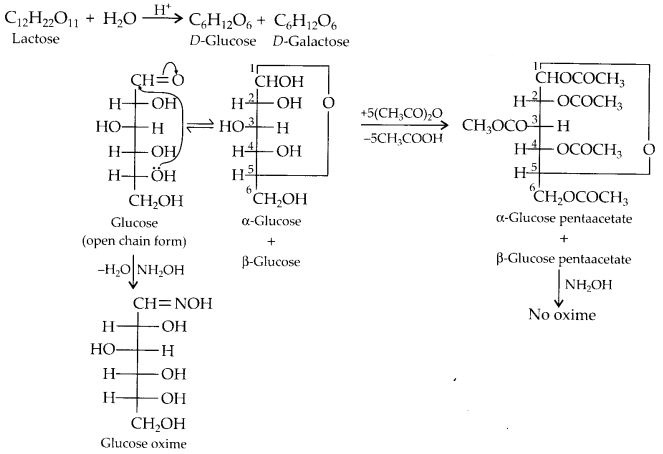
NCERT Solutions for Class 12 Chemistry Chapter 14, Question 3.
Solution.
The cyclic hemiacetal form of glucose contains an OH group at C-1 which gets hydrolysed in the aqueous solution to produce the open chain aldehydic form which then reacts with NH2OH to form the corresponding oxime. Therefore, glucose contains an aldehydic group. On the other hand, when glucose is reacted with acetic anhydride, the OH group at C-1, along with the four other OH groups at C-2, C-3, C-4 and C-6 form a pentaacetate. As the pentaacetate of glucose does not contain a free OH group at C-1, it cannot get hydrolysed in aqueous solution to produce the open chain aldehydic form and thus glucose pentaacetate does not react with NH2OH to form glucose oxime. Hence, glucose pentaacetate does not contain the aldehdye group.NCERT Solutions for Class 12 Chemistry Chapter 14, Question 4.
Solution.
The amino acids exist as zwitter ions, H3N+ OHR – COO–. Because of this dipolar salt like character they have strong dipole- dipole attractions. So, their melting points are higher than halo acids which do not have sail like character. Moreover, due to this salt like character, they interact strongly with H2O. Thus, solubility of amino acids in water is higher than that of the corresponding halo acids which do not have salt like character.NCERT Solutions for Class 12 Chemistry Chapter 14, Question 5.
Solution.
The boiling of an egg is a common example of denaturation of proteins present in the white portion of an egg.The albumin present in the white of an egg gets coagulated when the egg is boiled hard. The soluble globular protein present in it is denatured resulting in the formation of insoluble fibrous protein.
NCERT Solutions for Class 12 Chemistry Chapter 14, Question 6.
Solution.
Vitamin C is a water-soluble vitamin. Water-soluble vitamins when supplied regularly in the diet cannot be stored in out body because they are readily excreted in urine.NCERT Solutions for Class 12 Chemistry Chapter 14, Question 7.
Solution.
When a nucleotide from DNA containing thymine is completely hydrolysed, the products obtained are :- 2-deoxy-D(-)ribose.
- two pyrimidine i.e., guanine (G) and adenine (A).
- two purines, i.e., thymine (T) and cytosine (C) and
- phosphoric acid.
NCERT Solutions for Class 12 Chemistry Chapter 14, Question 8.
Solution.
A DNA molecule has two strands in which the four complementary bases pair each other, viz. cytosine (C) always pairs with guanine (G) while thymine (T) always pairs with adenine (A). Therefore, when a DNA molecule is hydrolysed the molar amount of cytosine is always equal to that of guanine and that of adenine is always equal to that of thymine RNA also contains four bases, the first three are same as in DNA but the fourth one is uracil (U).As in RNA there is no relationship between the quantities of four bases (C, G, A and U) obtained, therefore, the base-pairing principle, viz., (A) pairs with (U) and (C) pairs with (G) is not followed. So, unlike DNA, RNA has a single strand.
NCERT Exercises
NCERT Solutions for Class 12 Chemistry Chapter 14, Question 1.
Solution.
A carbohydrate that cannot be hydrolysed further to give simpler unit of polyhydroxy aldehyde or ketone is called a monosaccharide. With a few exceptions they have general formula, C,,H2„O„. About 20 monosaccharides are known to occur in nature. Some common examples are glucose, fructose, ribose, etc.NCERT Solutions for Class 12 Chemistry Chapter 14, Question 2.
Solution.
All those carbohydrates which reduce Fehling’s solution and Tollen’s reagent are referred to as reducing sugars. All monosaccharides whether aldose or ketose are reducing sugars.NCERT Solutions for Class 12 Chemistry Chapter 14, Question 3.
Solution.
Two main functions of carbohydrates are- Cell wall of bacteria and plants is made up of a polysaccharide, cellulose.
- Starch is the major food reserve material in plants.
NCERT Solutions for Class 12 Chemistry Chapter 14, Question 4.
Solution.
Monosaccharides : Ribose, 2-deoxyribose, galactose and fructoseDisaccharides : Maltose and Lactose
NCERT Solutions for Class 12 Chemistry Chapter 14, Question 5.
Solution.
Disaccharides on hydrolysis with dilute acids or enzymes yield two molecules of either the same or different monosaccharides. The two monosaccharides are joined together by an oxide linkage formed by the loss of a water molecule. Such a linkage between two monosaccharides units through oxygen atom is called glycosidic linkage.NCERT Solutions for Class 12 Chemistry Chapter 14, Question 6.
Solution.
The carbohydrates are stored in animal body as glycogen. It is also known as animal starch because its structure is similar to amylopectin. It is present in liver, muscles and brain. When the body needs glucose, enzymes break the glycogen down to glucose. Glycogen is also found in yeast and fungi.Starch is the main storage polysaccharide of plants. It is the most important dietary source for human being. High content of starch is found in cereals, roots, tubers and some vegetables. It is a polymer of two components-amylose (15-20%) which is water soluble and amylopectin(80-85%) which is water insoluble.
NCERT Solutions for Class 12 Chemistry Chapter 14, Question 7.
Solution.
- Sucrose on hydrolysis gives one unit of glucose and one unit of fructose.

- Lactose on hydrolysis with dilute acids yields an equimolar mixture of D-glucose and D-galactose.
NCERT Solutions for Class 12 Chemistry Chapter 14, Question 8.
Solution.
The basic structural difference between starch and cellulose is of linkage between the glucose units. In starch, there is a-D-glycosidic linkage. Both the components of starch-amylose and amylopectine are polymer of α-D-glucose. On the other hand, cellulose is a linear polymer of β-D-glucose in which C1 of one glucose unit is connected to C4 of the other through β-D-glycosidic linkage.NCERT Solutions for Class 12 Chemistry Chapter 14, Question 9.
- Hl
- Bromine water
- HNO3
Solution.
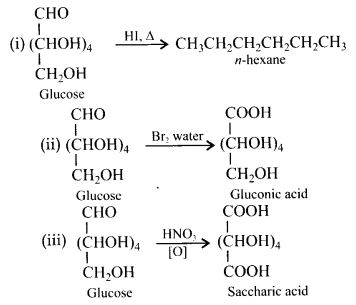
NCERT Solutions for Class 12 Chemistry Chapter 14, Question 10.
Solution.
The open chain structure of D-glucose OHC – (CHOH)4 – CH2OH fails to explain the following reactions :(i) Though it contains the aldehyde (-CHO) group, glucose does not give
2,4-DNP test, Schiff’s test and it does not form the hydrogen sulphite addition product with NaHSO3.
(ii) The pentaacetate of glucose does not T react with hydroxylamine (NH2OH) to form ’ the oxime indicating the absence of free -CHO group.
(iii) The formation of two anomeric methyl glycosides by glucose on reaction with CH3OH and dry HCl can be explained in terms of the cyclic structure. The equilibrium mixture of a-and (3-glucose react separately with methanol in the presence of dry HCl gas to form the corresponding methyl D-glucosides.

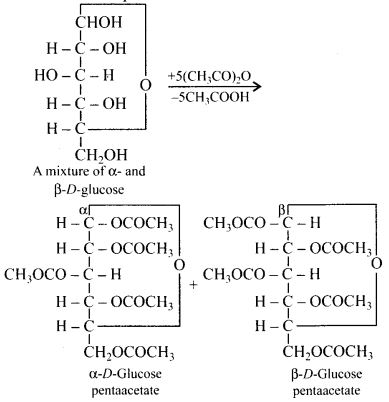
These pentaacetates donot have a free -OH group at C1 and hence are not hydrolysed in aqueous solution to produce the open chain aldehyde form and hence do not react with NH2OH to form glucose oxime.
(v) The existence of glucose in two crystalline forms termed as a and β-D-glucose can again be explained on the basis of cyclic structure of glucose and not by its open chain structure. It was proposed that one of the -OH groups may add to – CHO group and form a cyclic hemiacetal structure. It was found that glucose forms a 6-membered ring in which -OH at C – 5 is involved in ring formation. This explains the absence of -CHO group and also existence of glucose in two forms as shown below. These two forms exist in equilibrium with open chain structure.
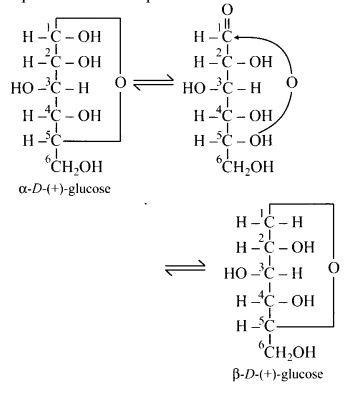
NCERT Solutions for Class 12 Chemistry Chapter 14, Question 11.
Solution.
There are about 20 amino acids which make up the bio-proteins. Out of these 10 amino acids (non-essential) are synthesised by our bodies and rest are essential in the diet (essential amino acids) and supplied to our bodies by food which we take because they cannot be synthesised in our body.e.g. Essential amino acid – Valine and Leucine
Non-essential amino acid – Glycine and Alanine
NCERT Solutions for Class 12 Chemistry Chapter 14, Question 12.
- Peptide linkage
- Primary structure
- Denaturation.
Solution.
(i) Peptide Linkage : Proteins are the polymers of a-amino acids which are connected to each other by peptide bond or peptide linkage. Chemically, peptide linkage is an amide formed between -COOH group and -NH2 group. The reaction between two molecules of similar or different amino acids, proceeds through the combination of the amino group of one molecule with the carboxyl group of the other. This results in the elimination of a water molecule and formation of a peptide bond -CO-NH-. The product of the reaction is called a dipeptide because it is made up of two amino acids. For example, when carboxyl group of glycine combines with the amino group of alanine we get a dipeptide, glycylalanine.(ii) Primary Structure : Proteins may have one or more polypeptide chains. Each polypeptide in a protein has amino acids linked with each other in a specific sequence and it is this sequence of amino acids that is said to be the primary structure of that protein. Any change in this primary structure i.e., the sequence of amine acids creates a different protein.
(iii) Denaturation : Protein found in a biological system with a unique three-dimensional structure and biological activity is called a native protein. When a protein in its native form, is subjected to physical change like change in temperature or chemical change in pH, the hydrogen bonds are disturbed. Due to this, globules unfold and helix get uncoiled and protein loses its biological activity. This is called denaturation of protein. During denaturation 2° and 3° structures are destroyed but 1° structure remains intact. The coagulation of egg white on boiling is a common example of denaturation. Another example is curdling of milk which is caused due to the formation of lactic acid by the bacteria present in milk.
NCERT Solutions for Class 12 Chemistry Chapter 14, Question 13.
Solution.
The secondary structure of protein refers to the shape in which a long polypeptide chain can exist. They are found to exist in two different types of structures viz, a-helix and P-pleated sheet structure. These structures arise due to the regular folding of the backbone of the polypeptide chain due to hydrogen bonding between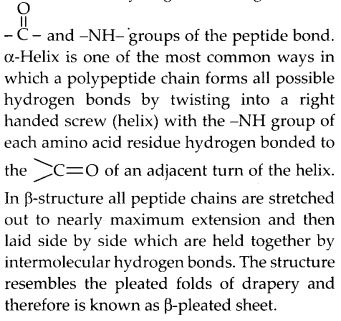
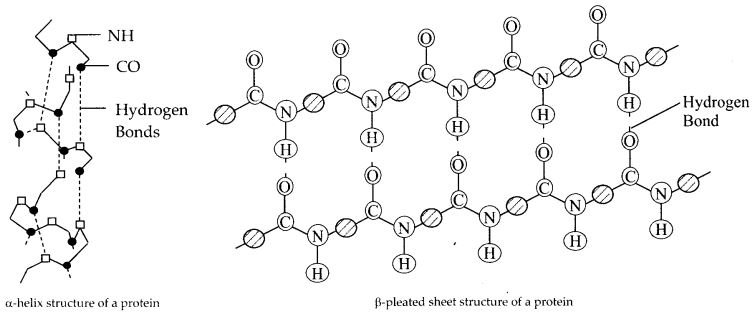
NCERT Solutions for Class 12 Chemistry Chapter 14, Question 14.
Solution.
α-Helix is one of the most common ways in which a polypeptide chain forms all possible hydrogen bonds by twisting into a right handed screw (helix) with the -NH group of each amino acid residue hydrogen bonded to the >C = O of an adjacent turn of the helix.NCERT Solutions for Class 12 Chemistry Chapter 14, Question 15.
Solution.
Characteristic differences between globular and fibrous proteins can be given as :Globular Proteins
- These are cross linked proteins and are condensation product of acidic and basic amino acids.
- These are soluble in water, mineral acids and bases.
- These proteins have three dimensional folded structure. These are stabilised by internal hydrogen bonding, e.g., egg albumin enzymes.
Fibrous Proteins
- These are linear condensation polymer
- These are insoluble in water but soluble in strong acids and bases.
- These are linear polymers held together by intermolecular hydrogen bonds. e.g., hair, silk.
NCERT Solutions for Class 12 Chemistry Chapter 14, Question 16.
Solution.
Due to dipolar or Zwitter ionic structure, amino acids are amphoteric in nature. The acidic character of the amino acids is due to the N+H3 group while the basic character is due to the COO– group.
NCERT Solutions for Class 12 Chemistry Chapter 14, Question 17.
Solution.
Life is possible due to the coordination of various chemical processes in living organisms. An example is the digestion of food, absorption of appropriate molecules and ultimately production of energy. This process involves a sequence of reactions and all these reactions occur in the body under very mild conditions. This occurs with the help of certain biocatalysts called enzymes. Almost all the enzymes are globular proteins. Enzymes are specific for a particular reaction and for a particular substrate. They are generally named after the compound or class of compounds upon which they work. For example, the enzyme that catalyses hydrolysis of maltose into glucose is named as maltose.
NCERT Solutions for Class 12 Chemistry Chapter 14, Question 18.
Solution.
Proteins are very sensitive to the action of heat, mineral acids, alkalies etc. On heating or on treatment with mineral acids, soluble forms of proteins such as globular proteins often undergo coagulation or precipitation to give fibrous proteins which are insoluble in water. This coagulation also results in the loss of the biological activity of the protein. That is why the coagulated proteins so formed are called denatured proteins.. Chemically, denaturation does not change the primary structure but brings about changes in the secondary and tertiary structure of proteins.NCERT Solutions for Class 12 Chemistry Chapter 14, Question 19.
Solution.
Vitamins are classified into two groups depending upon their solubility in water or fat.(i) Fat soluble vitamins : Vitamins which are soluble in fats and oils but insoluble in water are kept in this group. These are vitamins A, D, E and K. They are stored in liver and adipose (fat storing) tissues.
(ii) Water soluble vitamins : B group vitamins and vitamin C are soluble in water so they are grouped together. Water soluble vitamins must be supplied regularly in diet
because they are readily excreted in urine and cannot be stored (except vitamin B12) in our body.
Vitamin K is responsible for coagulation of blood.
NCERT Solutions for Class 12 Chemistry Chapter 14, Question 20.
Solution.
Deficiency of vitamin A causes Xerophthalmia (hardening of cornea of the eye) and night blindness. So its use is essential to us. It is available in fish liver oil, carrots, butter and milk. It promotes growth and increases resistance to diseases. Vitamin C is very essential to us because its deficiency causes Scurvy (bleeding of gums) and pyorrhea (loosening and bleeding of teeth). Vitamin C increases resistance of the body towards diseases. Maintains healthy skin and helps cuts and abrasions to heat properly. It is soluble in water. It is present in citrus fruits, e.g.,oranges, lemons, amla, tomato. green vegetables (Cabbage) chillies, sprou pulses and germinated grains.NCERT Solutions for Class 12 Chemistry Chapter 14, Question 21.
Solution.
Nucleic acids : They constitute an important class of biomolecules which are found in the nuclei of all living cells in the form of nucleoproteins (i.e., proteins containing nucleic acid as the prosthetic group). Nucleic acids are the genetic materials of the cells and are responsible for transmission of hereditary effect from one generation to the other and also carry out the biosynthesis of proteins. Nucleic acids are biopolymers (i.e., polymers present in the living system). The genetic information coded in nucleic acids controls the structure of all proteins including enzymes and thus governs the entire metabolic activity in the living organism.Two important functions of nucleic acids are :
- Replication : The process by which a single DNA molecule produces two identical copies of itself is called replication.
- Protein Synthesis : DNA may be regarded as the instrument manual for the synthesis of all proteins present in the cell.
NCERT Solutions for Class 12 Chemistry Chapter 14, Question 22.
Solution.
Nucleoside : A nucleoside contains only two basic components of nucleic acids, i.e., a pentose sugar and a nitrogenous base. It may be represented as Sugar-base. Depending upon the type of sugar present, nucleosides are of two types :- Ribonucleosides and
- Deoxyribonucleosides.
Nucleotides : A nucleotide contains all the three basic components of nucleic acids, i.e., a phosphoric acid group, a pentose sugar and a nitrogenous base. In other words, nucleotides are nucleoside monophosphates.
Depending upon the type of sugar present, nucleotides like nucleosides are of two types :
- Ribonucleotides and
- Deoxyribonucleotides.
NCERT Solutions for Class 12 Chemistry Chapter 14, Question 23.
Solution.
Two nucleic acid chains are wound about each other and held together by hydrogen bonds between pairs of bases. The trands are complementary to each other because the hydrogen bonds are formed between specific pairs of bases. Adenine forms hydrogen bonds with thymine whereas cytosine forms hydrogen bonds with guanine.NCERT Solutions for Class 12 Chemistry Chapter 14, Question 24.
Solution.
Difference between DNA and RNA.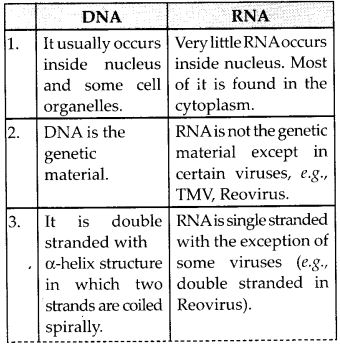
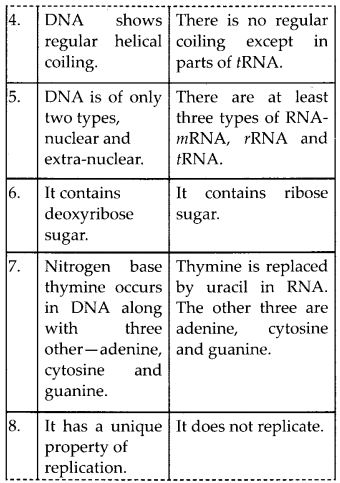
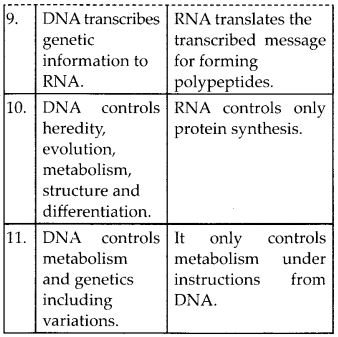
NCERT Solutions for Class 12 Chemistry Chapter 14, Question 25.
Solution.
RNA molecules are of three types and they perform different functions. They are named as messenger RNA (m-RNA), ribosomal RNA (r-RNA) and transfer RNA (t-RNA).NCERT Class 12 Chemistry
Class 12 Chemistry Chapters | Chemistry Class 12 Chapter 14
Chapterwise NCERT Solutions for Class 12 Chemistry
-
NCERT Solutions For Class 12 Chemistry Chapter 1 The Solid State
NCERT Solutions For Class 12 Chemistry Chapter 2 Solutions
NCERT Solutions For Class 12 Chemistry Chapter 3 Electro chemistry
NCERT Solutions For Class 12 Chemistry Chapter 4 Chemical Kinetics
NCERT Solutions For Class 12 Chemistry Chapter 5 Surface Chemistry
NCERT Solutions For Class 12 Chemistry Chapter 6 General Principles and Processes of Isolation of Elements
NCERT Solutions For Class 12 Chemistry Chapter 7 The p Block Elements
NCERT Solutions For Class 12 Chemistry Chapter 8 The d and f Block Elements
NCERT Solutions For Class 12 Chemistry Chapter 9 Coordination Compounds
NCERT Solutions For Class 12 Chemistry Chapter 10 Haloalkanes and Haloarenes
NCERT Solutions For Class 12 Chemistry Chapter 11 Alcohols Phenols and Ethers
NCERT Solutions For Class 12 Chemistry Chapter 12 Aldehydes Ketones and Carboxylic Acids
NCERT Solutions For Class 12 Chemistry Chapter 13 Amines
NCERT Solutions For Class 12 Chemistry Chapter 14 Biomolecules
NCERT Solutions For Class 12 Chemistry Chapter 15 Polymers
NCERT Solutions For Class 12 Chemistry Chapter 16 Chemistry in Everyday Life
| NCERT Solutions for Class 12 All Subjects | NCERT Solutions for Class 10 All Subjects |
| NCERT Solutions for Class 11 All Subjects | NCERT Solutions for Class 9 All Subjects |

Post a Comment
इस पेज / वेबसाइट की त्रुटियों / गलतियों को यहाँ दर्ज कीजिये
(Errors/mistakes on this page/website enter here)